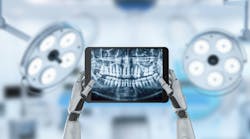Smart feedback systems in preventive dentistry
What you'll learn in this article
- Why patients tend to overestimate their oral hygiene and how objective digital tools, including AI-based plaque detection, provide more accurate assessments
- How visual technologies like intraoral cameras, 3D models, and DentView improve patient understanding, motivation, and treatment acceptance
- How encouragement-focused feedback and personalized digital platforms support lasting self-care habits and more effective prevention strategies
Preventive dentistry is evolving as digital technologies increasingly complement traditional dental care and patient guidance. Innovative oral health tools can now make self-care more visible and measurable, helping individuals improve their daily hygiene habits. At the same time, these tools enable dental professionals to provide more effective guidance and personalized treatment for their patients.
One example of such technology is DentView, a system from Finland that combines an interactive in-clinic kiosk, a mobile app for patients, and a professional portal for clinicians. It provides feedback on oral hygiene, highlights risk factors like nicotine use, and gives personalized tips for better brushing and flossing. DentView has received a Digi-HTA recommendation, an official Finnish evaluation of digital health tools based on effectiveness, safety, usability, data security, and cost-efficiency.1
A lighter, portable version of the system is also available. Instead of a fixed kiosk, clinics can use the system on a tablet, through a web browser, or even within an app—making it easy to deploy wherever needed.
Turning dental care customers into active partners
Tools that make oral hygiene visible to patients reflect a broader shift in dentistry toward prevention and active patient participation, experts say. Technologies such as intraoral cameras, dental viewers, and interactive software can help patients understand the state of their oral health and stay motivated to practice good daily self-care and follow professional care advice.
According to Ahamed (2024), visual tools such as digital images, 3D models, diagrams, and interactive platforms help patients better understand their treatment needs and take an active role in their oral health.2 They also build trust and encourage patients to maintain good daily hygiene between visits.
An article in Dental Practice Insider adds that visual aids make complex dental procedures easier to grasp, show patients what to expect, and support more informed decisions. Using 3D images and photos can improve communication, strengthen trust, and even increase treatment acceptance rates by up to 25%.2 Beyond patient education, these tools also help dentists provide more personalized advice and streamline clinic workflows, resulting in more efficient and more effective dental care.2
Professor Marja-Liisa Laitala from the University of Oulu in Finland notes that patients tend to overrate their oral hygiene when asked to report it themselves. This observation is backed by research: A study published in BMC Oral Health showed only a moderate correlation between self-reported cleanliness and actual plaque levels, meaning many patients overestimated how well they had cleaned their teeth.3
The study highlights the limitations of self-assessment and underscores the need for objective tools—such as AI-based plaque detection—to support more accurate feedback and better oral health outcomes.3
“Patients’ behavior plays a key role in oral health, but measuring it accurately has always been difficult,” Laitala says.
Encouragement over criticism pays off
Dr. Eeva Malinen, a dentist involved in developing DentView technology, says the motivation behind the development of the system was simple: “Proper self-care has a major impact on both oral and overall health. The best results come when patients maintain healthy habits after treatment.”
The system shows patients their oral care status, highlights problem areas, and gives personalized tips. For professionals, it provides an overview of their patients’ self-care habits and risk factors to oral diseases, such as nicotine use. It can indicate interest in prosthetic or esthetic treatments. This helps dentists guide patients effectively while focusing on treating oral diseases sustainably.
“People like tracking their oral hygiene and getting feedback without comparisons. Seeing the true state of their oral care motivates them to keep up good habits long after professional treatment,”—Dr. Eeva Malinen
The technology also reduces guilt or embarrassment and empowers patients by giving them control over their oral health.
“Understanding the patient’s starting point allows us as dental professionals to give feedback that encourages improvement rather than criticism,” she adds.
What the research says
The World Health Organization reports that 3.5 billion people worldwide live with oral diseases, making them the most common noncommunicable diseases.4 Poor oral hygiene is also linked to systemic conditions such as diabetes and cardiovascular disease.5,6
Professor Laitala emphasizes that new AI-based technologies can support both patients and dental professionals.
“Self-assessment does not always reflect the actual level of oral hygiene. That’s why there is a real need for innovative technologies that can reveal the true status of oral hygiene habits,”—Professor Marja-Liisa Laitala
She says that ineffective brushing and flossing techniques are a key cause of cavities and gum disease. While many people brush regularly, they may still be at risk if their technique is incorrect. Good oral hygiene habits are essential for maintaining oral health yet often overlooked. That’s why clear, personalized guidance is so important.
“Patients need simple, understandable feedback on how they care for their teeth between dental visits,” she emphasizes. “Most oral diseases can be prevented with proper home care. Brushing twice a day isn’t enough if the technique isn’t effective.”
With the focus of oral health care shifting from resource-intensive, corrective treatment toward prevention and active patient self-care, the professor concludes that new technologies that reveal the true status of oral self-care play an important role.
Editor’s note: This article first appeared in Clinical Insights newsletter, a publication of the Endeavor Business Media Dental Group. Read more articles and subscribe.
References
- Digi-HTA recommendation for DentView. OuluHealth. March 9, 2024. https://ouluhealth.fi/digi-hta-recommendation-for-dentview/
- Ahamed S. Utilizing visual tools for dental patient education. Dental Practice Insider. Updated April 12, 2024. https://dentalpracticeinsider.org/visual-aids-for-patient-education-in-dentistry/
- Eidenhardt Z, Busse S, Margraf-Stiksrud J, Deinzer R. Patients’ awareness regarding the quality of their oral hygiene: development and validation of a questionnaire. BMC Oral Health. December 22, 2022. https://bmcoralhealth.biomedcentral.com/articles/10.1186/s12903-022-02659-4
- Global oral health status report: towards universal health coverage for oral health by 2030. World Health Organization. November 18, 2022. https://www.who.int/publications/i/item/9789240061484
- Natarajan P, Madanian S, Marshall S. Investigating the link between oral health conditions and systemic diseases: a cross-sectional analysis. Sci Rep.2025;15(1):10476. doi:10.1038/s41598-025-92523-6
- Tonetti MS, Van Dyke TE; working group 1 of the joint EFP/AAP workshop. Periodontitis and atherosclerotic cardiovascular disease: consensus report of the Joint EFP/AAP Workshop on Periodontitis and Systemic Diseases. J Periodontol. 2013;84(4 Suppl):S24-S29. doi:10.1902/jop.2013.1340019
Tackling dental care gaps in Scandinavia with AI-powered tools
Public oral health care in many European countries—particularly in rural and northern parts of Scandinavia—is facing ongoing challenges due to limited staffing and resources. These shortages lead to delayed treatments, increased costs, and reduced focus on preventive care.
To address these gaps, a new project called Digital Support Solutions for Oral Health Care (DSS-Oral) was launched in March 2025, coordinated by the University of Oulu, Finland.
Over the next three years, the project will create digital tools to detect oral diseases, assess risks, and improve prevention. The goal of the initiative is to help dental professionals more easily identify patients who need care and to assess disease risks in a faster and more cost-effective way.
During the study, scientists will develop artificial intelligence that can analyze dental images to identify teeth, cavities, gum disease, and plaque. They will also create tools that estimate each patient’s individual risk based on survey data. These AI-based solutions will be tested and piloted in real dental care settings.
The project, led by Professor Marja-Liisa Laitala from the University of Oulu, is funded by the European Structural and Investment Funds (INTERREG) and supported by Mid Sweden University, a state university in Sweden with campuses in Sundsvall and Östersund, located in the central part of the Nordic country.
About the Author

Nina Garlo-Melkas, MSc
Nina Garlo-Melkas, MSc, is a health and science journalist.




